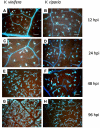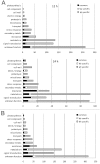General and species-specific transcriptional responses to downy mildew infection in a susceptible (Vitis vinifera) and a resistant (V. riparia) grapevine species
- PMID: 20167053
- PMCID: PMC2831845
- DOI: 10.1186/1471-2164-11-117
General and species-specific transcriptional responses to downy mildew infection in a susceptible (Vitis vinifera) and a resistant (V. riparia) grapevine species
Abstract
Background: Downy mildew is a destructive grapevine disease caused by Plasmopara viticola (Berk. and Curt.) Berl. and de Toni, which can only be controlled by intensive fungicide treatments. Natural sources of resistance from wild grapevine (Vitis) species are used in conventional breeding approaches, but the signals and effectors involved in resistance in this important crop species are not well understood.
Results: Early transcriptional changes associated with P. viticola infection in susceptible V. vinifera and resistant V. riparia plants were analyzed using the Combimatrix microarray platform. Transcript levels were measured 12 and 24 h post-inoculation, reflecting the time points immediately preceding the onset of resistance in V. riparia, as determined by microscopic analysis. Our data indicate that resistance in V. riparia is induced after infection, and is not based on differences in basal gene expression between the two species. The strong and rapid transcriptional reprogramming involves the induction of pathogenesis-related proteins and enzymes required for the synthesis of phenylpropanoid-derived compounds, many of which are also induced, albeit to a lesser extent, in V. vinifera. More interestingly, resistance in V. riparia also involves the specific modulation of numerous transcripts encoding components of signal transduction cascades, hypersensitive reaction markers and genes involved in jasmonate biosynthesis. The limited transcriptional modulation in V. vinifera represents a weak attempted defense response rather than the activation of compatibility-specific pathways.
Conclusions: Several candidate resistance genes were identified that could be exploited in future biotechnological approaches to increase disease resistance in susceptible grapevine species. Measurements of jasmonic acid and methyl jasmonate in infected leaves suggest that this hormone may also be involved in V. riparia resistance to P. viticola.
Figures






References
-
- Grenville-Briggs LJ, van West P. The biotrophic stages of oomycete-plant interactions. Adv Appl Microbiol. 2005;57:217–243. full_text. - PubMed
-
- Grando MS, Bellin D, Edwards KJ, Pozzi C, Stefanini M, Velasco R. Molecular linkage maps of Vitis vinifera L. and Vitis riparia Mchx. Theor Appl Genet. 2003;106:1213–1224. - PubMed
-
- Merdinoglu D, Wiedeman-Merdinoglu S, Coste P, Dumas V, Haetty S, Butterlin G, Greif C. Genetic analysis of downy mildew resistance derived from Muscadinia rotundifolia. VIII International Conference on Grape Genetics and Breeding; Kecskemet, Hungary. 2003. pp. 451–456.
Publication types
MeSH terms
Substances
LinkOut - more resources
Full Text Sources
Molecular Biology Databases

